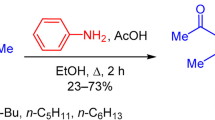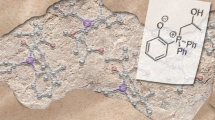Conclusions
-
1.
The acylation of 1,1,2,2-tetramethyl-, 1,1,2-trimethyl-, and 1,1-dimethyl-2-ethytcyclopropanes by pivaloyl tetrafluoroborate leads to the formation of stable carboxonium salts, which react with hydride ion donors to yield derivatives of tetrahydrofuran and undergo hydrolysis in water to yield derivatives of 4, 5-dihydrofuran.
-
2.
Direct opening of the cyclopropane ring by the action of the\(R\mathop C\limits^ \oplus O\) electrophile does not occur in the acylation of the gem-dideuterocyclopropanes under the same conditions. For methyl-substituted cyclopropanes, a predominant pathway through an isomerization into olefins accompanied by various carbonium ion rearrangements is likely.
-
3.
For 1,1-dimethyl-2-ethylcyclopropane and norcarane which have a methylene group adjacent to the cyclopropane ring, the most likely direction of the reaction is the initial attack of the pivaloyl cation on the C-H bond of the α-methylene fragment with subsequent opening of the cyclopropane ring and formation of stable carboxonium complexes. This type of mechanism of electrophilic opening of a three-membered ring previously has not been considered.
Similar content being viewed by others
Literature cited
Yu. V. Tomilov, V. A. Smit, and O. M. Nefedov, Izv. Akad. Nauk SSSR, Ser. Khim., 2620 (1975).
Yu. V. Tomilov, V. A. Smit, and O. M. Nefedov, Izv. Akad. Nauk SSSR, Ser. Khim., 1439 (1974); 2512 (1976).
Yu. V. Tomilov, V. A. Smit, and O. M. Nefedov, Izv. Akad. Nauk SSSR, Ser. Khim., 2614 (1975).
W. Rundell and K. Besserer, Lieb. Ann. Chem.,751, 168 (1971).
O. V. Lubinskaya, A. S. Shashkov, V. A. Chertkov, and V. A. Smith (W. A. Smit), Synthesis, 742 (1976).
R. Ya. Levina, V. N. Kostin, and P. A. Gembitskii, Zh. Obshch. Khim.,30, 868 (1960).
H. Hart and R. H. Schlosberg, J. Am. Chem. Soc.,90, 5189 (1968).
G. A. Olah, Y. Halpern, J. Shan, and Y. K. Mo, J. Am. Chem. Soc.,95, 4960 (1973).
J. T. Keating and P. S. Skell, in: Carbonium Ions (ed. by G. A. Olah and P. Schleyer), Vol. 2, Wiley-Interscience, New York (1970), p. 573.
G. A. Olah, Usp. Khim.,44, 793 (1975).
G. A. Olah, A. Germain, H. C. Lin, and D. A. Forsych, J. Am. Chem. Soc.,97, 2928 (1975).
H. E. Simmons, T. L. Cairns, S. A. Vladuchick, and C. M. Hoiness, Org. React.,20, 1 (1973).
C. D. Poulter, R. S. Boikess, J. I. Brauman, and S. Winstein, J. Am. Chem. Soc.,94, 2291 (1972).
Author information
Authors and Affiliations
Additional information
For preceding communication, see [1].
Translated from Izvestiya Akademii Nauk SSSR, Seriya Khimicheskaya, No. 12, pp. 2744–2751, December, 1978.
Rights and permissions
About this article
Cite this article
Tomilov, Y.V., Smit, V.A. & Nefedov, O.M. The alkylation of alkylcyclopropanes by pivaloyl tetrafluoroborate. Russ Chem Bull 27, 2448–2454 (1978). https://doi.org/10.1007/BF00941094
Received:
Issue Date:
DOI: https://doi.org/10.1007/BF00941094




